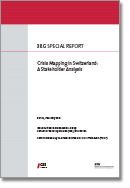Crisis Mapping in Switzerland: A Stakeholder Analysis

Autor(en): Florian Roth, Jennifer Giroux, Michel Herzog
Serie: Risk and Resilience Reports
Verlag(e): Center for Security Studies (CSS), ETH Zurich
Publikationsjahr: 2013
